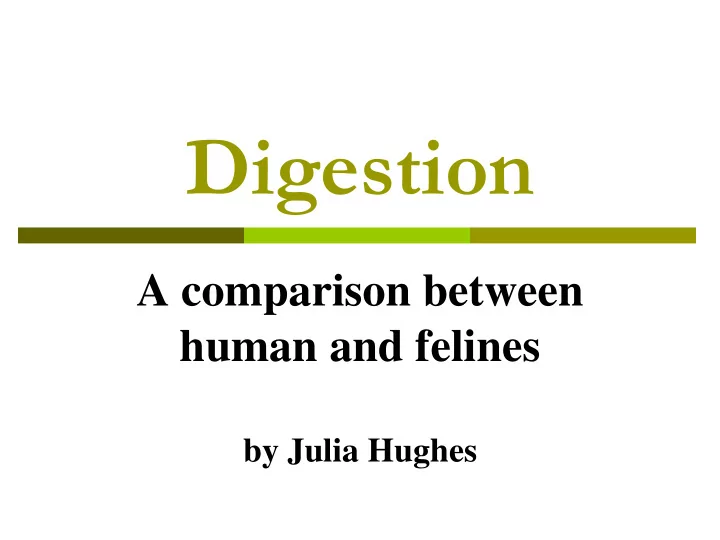

Digestion A comparison between human and felines by Julia Hughes
Definition Digestion is the process by which chemicals are broken down into smaller components by the body that can be absorbed by the blood stream. Mechanical and chemical digestion begins in the mouth where food is crushed and ground by teeth, mixed with saliva – produced by the salivary glands - which helps to break down starches.
Definition (cont…) Digestive enzymes are produced in the stomach which in turn, continues to break food down mechanically and chemically through the mixing with enzymes and the churning of the stomach.
Definition (cont…) Absorption occurs in the stomach and gastrointestinal tract (also known as the alimentary canal) and finishes with excretion or defecation which is the elimination of solid, semisolid or liquid waste material or faeces from the digestive tract via the anus.
The Human Digestive System
The Feline Digestive System
Teeth The Human Skull The Feline Skull
Teeth Human Feline Incisors 4/4 6/6 Canines 2/2 2/2 Pre-molars 4/4 6/4 Molars 6/6 2/2
Big cats
Tongue and Gums Human tongue Cat tongue
Salivary Glands Human Salivary Glands Cat Salivary Glands 1 Parotid gland 2 Sublingual gland 3 Submandibular gland 4 Esophagus 5 Tongue 6 Masseter muscle 7 Larynx 8 Trachea
Ingestion The action of chewing and mixing food with saliva turns it into a soft paste, which is then swallowed and passed into the oesophagus. The oesophagus is a small hose-like tube, which connects the mouth to the stomach. As it leaves the mouth, it follows a straight path through the neck and chest, passing near the heart through the diaphragm muscle and finally entering the stomach. The oesophagus walls are composed of muscles, which move in wave-like contractions to push food into the stomach called peristalsis.
Digestion Human Stomach Cat Stomach
Absorption Human Intestines Cat Intestines
End Julia Hughes HNC Animal Studies
Recommend
More recommend